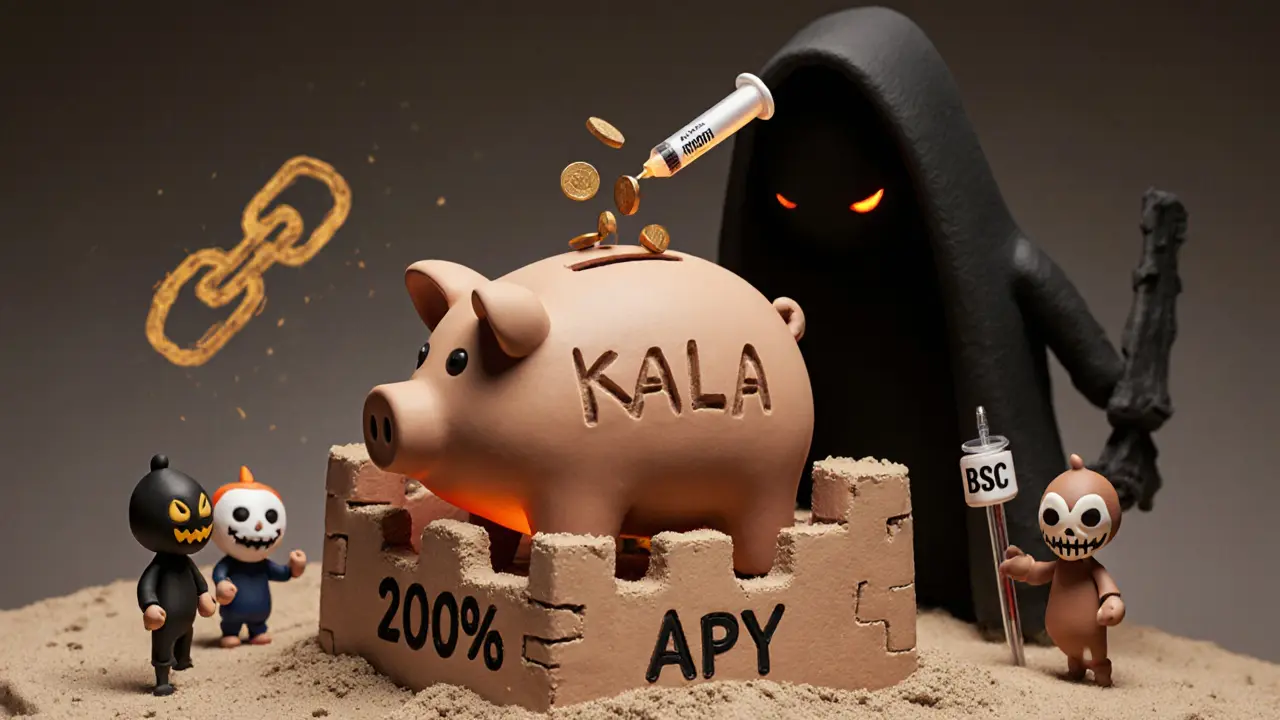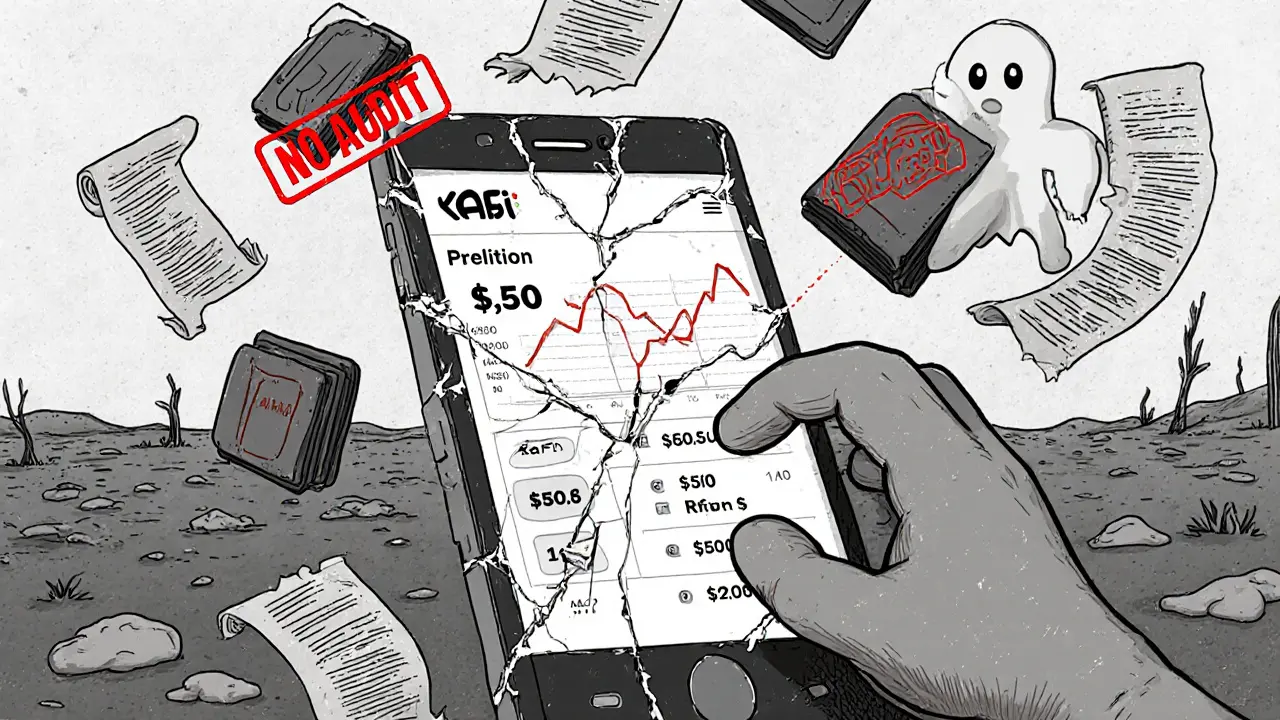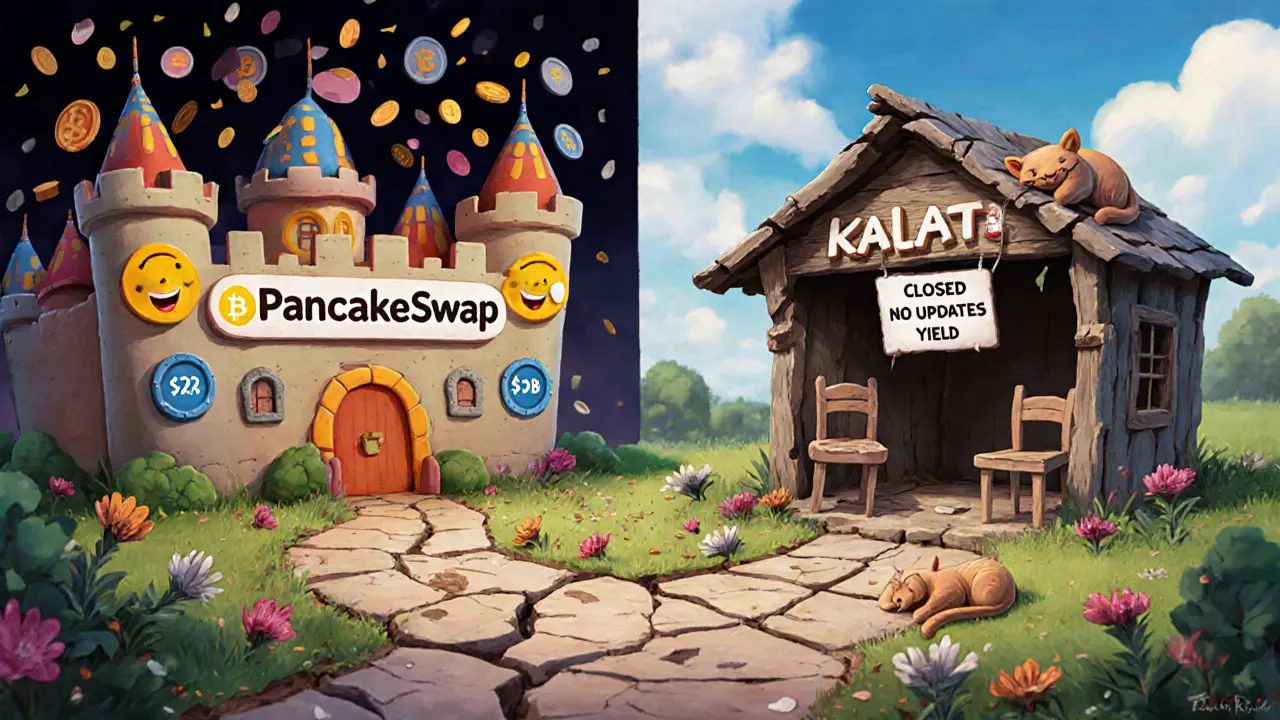Kalata Protocol Crypto Review: Is KALA a Safe DeFi Investment or a High-Risk Scam?
 Dec, 7 2024
Dec, 7 2024
Kalata Protocol Yield & Risk Calculator
Important Risk Warning
WARNING: Kalata Protocol is classified as a high-risk DeFi project. The article states it has no team transparency, no security audits, and known vulnerabilities. This calculator shows only theoretical returns based on current rates, which can change rapidly or disappear entirely.
People keep asking if Kalata Protocol is a crypto exchange. It’s not. It’s a DeFi protocol built on Binance Smart Chain that lets you farm yield by locking up tokens - mostly KALA, its own native coin. But calling it an exchange is like calling a gas station a car manufacturer. You can fill up there, but it doesn’t build the car. And in this case, the car might not even be roadworthy.
What Kalata Protocol Actually Does
Kalata Protocol (KALA) launched in late 2023 as a yield farming platform. That means you deposit tokens - like BUSD or BNB - into a pool, and the protocol pays you interest in KALA tokens. At its peak, some pools offered over 350% APY. Today, those returns have dropped to between 28.5% and 147.3%, depending on the pool. That’s still high compared to your bank account, but it’s not magic. It’s math. And the math is built on thin air.
The protocol runs on BSC, which keeps transaction fees low - around 5 to 10 cents per trade. That’s nice if you’re depositing $50. But if you try to move $5,000? You’ll face nearly 9% slippage because the liquidity pools are tiny. For comparison, PancakeSwap has over $1.7 billion locked in similar pools. Kalata has $87,342. That’s not a platform. That’s a hobby project with a website.
No Team, No Audits, No Trust
Who built Kalata? No one knows. The team is anonymous. No LinkedIn profiles. No public GitHub commits beyond a few outdated files from early 2024. No corporate registration. No legal entity. That’s not just unusual - it’s a red flag flashing in neon.
And it gets worse. The smart contracts were verified on BscScan, but they’ve never been audited by a reputable firm like OpenZeppelin, CertiK, or Quantstamp. Security researcher Alex Svanevik of Nansen flagged this as a critical vulnerability. Why? Because without an audit, the code could have backdoors. There’s evidence of admin keys that could mint unlimited KALA tokens. No one’s proven they’ve been used - yet. But the capability exists.
Even worse, the contract still has the old approve() function flaw that was patched in nearly every legitimate DeFi project by 2023. A Reddit user named u/DeFi_Safety_Audit pointed this out in November 2025. PeckShield, a blockchain security monitor, confirmed it. That means someone could trick you into approving unlimited access to your wallet. Then they drain it. And there’s no way to reverse it.
Trading Volume? Barely There
Kalata’s 24-hour trading volume is around $156,732. That’s less than what a single top-tier DeFi token moves in five minutes. Uniswap moves $3.2 billion daily. PancakeSwap moves $200 million. Kalata? It doesn’t even crack the top 200 DeFi protocols by activity. It’s buried in the bottom tier - the “micro-cap graveyard” where projects go to die quietly.
There are only 2,841 unique wallets that have interacted with Kalata’s contracts in the last six months. Over 70% of those wallets hold less than $50 worth of KALA. This isn’t adoption. This is speculation by people chasing quick gains. And when the pumps stop, the buyers vanish. The price drops. And the liquidity evaporates.

Customer Support? Don’t Count on It
Want help? Good luck. The official Telegram group has 1,284 members. The average response time to a support question? 72 hours. That’s three full days. Meanwhile, Trustpilot has 17 verified reviews with an average rating of 1.9 out of 5. Common complaints: withdrawals stuck for over 72 hours, customer support ignoring messages, and smart contract errors that burn your gas fees without completing the trade.
One user lost $87 in gas fees because the transaction failed mid-process - and got no refund. No one responded. No explanation. That’s not a service. That’s gambling with your money.
Is It a Scam?
It’s not confirmed as a rug pull - yet. But the signs are textbook. Anonymous team. No audits. Low liquidity. High APY that’s already dropped 60% from launch. No roadmap updates since 2024. Twitter hasn’t posted since May 2025. The project’s own analytics dashboard shows declining user activity.
Experts agree. Galaxy Digital gave it a 2.1/5. F-Secure labeled it a “High-Risk DeFi Project.” JPMorgan outright called it “non-investible.” Even retail-focused analysts like Crypto Wendy, who gave it a 3.8/5, admitted it’s only worth risking under $500.
There’s a difference between high risk and no risk. Kalata sits in the highest risk category. Delphi Digital calls projects like this “ultra-low-cap DeFi” - the most dangerous segment in crypto. These aren’t startups. They’re experiments with your money as the test subject.
Who Should Use It?
Only one kind of person should touch Kalata: someone who understands the risk, has money they can afford to lose completely, and treats it like a lottery ticket - not an investment.
If you’re a beginner and you see “200% APY” and think, “This is easy money,” walk away. If you’re trying to build a portfolio, avoid it. If you care about security, privacy, or long-term value - don’t even open the website.
The only scenario where Kalata makes sense is if you deposit $100, farm KALA for 30 days, cash out $120, and consider the $20 profit a fun side hustle. Not a strategy. Not a plan. Just a gamble with low stakes.

What About the Future?
Kalata’s roadmap promised a mobile app and cross-chain support by mid-2024. Neither happened. No updates. No explanations. No commits to GitHub since January 2024. The team has gone silent.
Blockchain researcher Wendy O’Shea predicts projects like this have 18 to 24 months before they’re abandoned or exploited. TokenInsight says Kalata has a “high probability of abandonment within 12 months.”
That’s not speculation. That’s pattern recognition. When a project stops updating, stops communicating, and stops growing - it’s already dead. You’re just waiting for the lights to go out.
Alternatives That Actually Work
If you want DeFi yield without the risk of vanishing overnight, try these instead:
- PancakeSwap - Runs on BSC, same low fees, but with $1.7B in liquidity and full audits.
- Uniswap - The largest DEX on Ethereum. High fees, but unmatched security and liquidity.
- Aave - Lending and borrowing with real interest rates, not fake APYs.
- Compound - Transparent governance, real token voting, and institutional backing.
These platforms have teams, audits, active development, and real users. They’re not perfect. But they’re not gambling dens.
Final Verdict
Kalata Protocol is not a crypto exchange. It’s a high-risk, low-liquidity DeFi project with no team, no audits, and no future. The returns look tempting, but they’re built on sand. One day, the tide goes out - and you’re left holding a token worth nothing.
Don’t invest. Don’t trust. Don’t even deposit. If you’ve already put money in, consider it a lesson. And get out while you still can.
Is Kalata Protocol a real crypto exchange?
No, Kalata Protocol is not an exchange. It’s a DeFi yield farming platform built on Binance Smart Chain. You can’t buy or sell cryptocurrencies directly on Kalata. Instead, you deposit tokens into liquidity pools to earn KALA rewards. It lacks trading pairs, order books, or wallet-to-wallet transfers - all key features of a true exchange.
Can I trust Kalata Protocol with my money?
No, not reliably. The team is anonymous, the smart contracts have never been audited by a reputable firm, and there are known security flaws like the unpatched approve() function. Multiple blockchain analysts and security firms, including F-Secure and Galaxy Digital, classify it as high-risk. While no rug pull has occurred yet, the conditions for one are all in place.
Why are the APYs so high on Kalata?
The high APYs are unsustainable by design. They’re fueled by new investors’ deposits, not real revenue. When the flow of new money slows - which it already has - yields drop sharply. Initial rates of 350%+ have fallen to under 150%. This is a classic yield farming pump-and-dump cycle. The goal isn’t long-term growth - it’s quick token sales before the liquidity dries up.
What happened to Kalata’s roadmap?
Kalata’s roadmap promised a mobile app and cross-chain bridges by Q2 2024. Neither was delivered. There have been no official updates since early 2024. The Twitter account has posted only 12 times in 2025. GitHub hasn’t been updated since January 2024. This lack of development activity signals the project is effectively abandoned.
Is Kalata Protocol listed on major exchanges like Coinbase or Kraken?
No. Kalata is not listed on any major exchange like Coinbase, Kraken, Binance, or Gemini. Its only trading pairs are on small, low-volume platforms like ProBit and MEXC. These exchanges have lower listing standards, which is why Kalata appears there. Major exchanges require audits, team transparency, and liquidity - all of which Kalata lacks.
How do I withdraw my funds from Kalata Protocol?
You can withdraw your deposited tokens (like BUSD or BNB) and earned KALA through the platform’s interface. But many users report delays of over 72 hours. Some have experienced failed withdrawals where gas fees were burned but funds weren’t returned. Always test with a small amount first. Never deposit more than you’re willing to lose - especially since customer support is nearly non-existent.
SARE Homes
November 26, 2025 AT 10:11Let me just say this: if you’re still holding KALA, you’re not investing-you’re participating in a digital pyramid scheme with better UI design. The approve() vulnerability alone should’ve triggered a panic sell in 2024, and yet here we are, watching people throw money into a black hole labeled ‘yield.’ This isn’t DeFi. It’s a digital casino where the house prints its own chips. I’ve seen rug pulls with more transparency. At least the fake moon missions had a press release.
Eddy Lust
November 27, 2025 AT 12:17man i read this whole thing and i just... felt sad? like, these people put so much work into making this thing look legit-website, analytics, even fake roadmap dates-but nobody’s home. it’s like finding a fully furnished house with no people, no lights, no fridge humming. the gas fees alone? that’s the sound of people paying to learn the hard way. i lost $47 on this last year. didn’t even get a ‘lol’ from support. just silence. i still check the address every now and then. hoping for a miracle. i know it’s dumb.